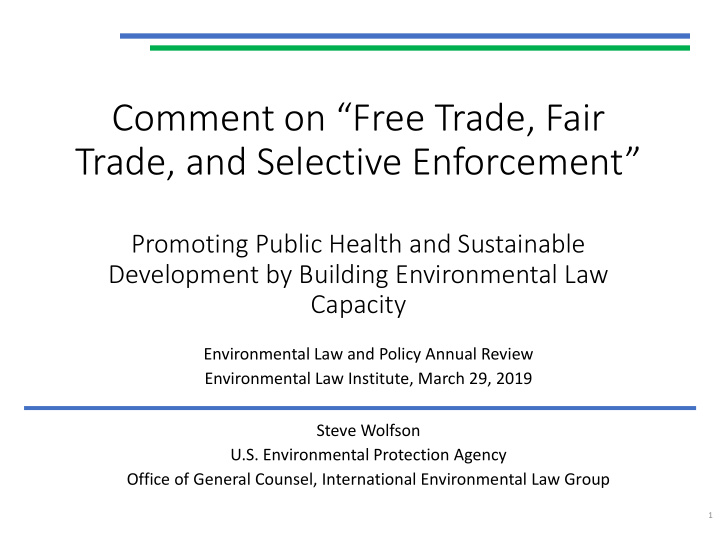



Comment on “Free Trade, Fair Trade, and Selective Enforcement” Promoting Public Health and Sustainable Development by Building Environmental Law Capacity Environmental Law and Policy Annual Review Environmental Law Institute, March 29, 2019 Steve Wolfson U.S. Environmental Protection Agency Office of General Counsel, International Environmental Law Group 1
WTO Obligations and Environmental Policy • Trade obligations can have impacts on environmental policy, depending on how they are written and applied. • Renewables programs that were challenged had domestic content requirements • Article references 2013 World Bank report indicating that domestic content requirements are common in other energy programs • Is additional information available that would enable an assessment of strength of those cases? • What cases were renewables companies advocating for? Who do they view as their competitors? • Broad efforts in OECD and elsewhere • litigation vs. negotiation
Improving Environmental Governance • International and national efforts • Trade and Environment
Trade and Environment and Governance • Countries that open up trade are often ready to modernize in other ways, including upgrading their environmental laws – environmental cooperation often linked to trade liberalization • Effective Environmental Governance promotes level playing field, fosters a stable business climate, and spurs innovative technologies. • Countries around the world are innovating to advance environmental rule of law in their own legal systems.
Pollution and Health “For decades, pollution and its harmful effects on people’s health, the environment, and the planet have been neglected both by governments and the international development community.” Pamela Das and Richard Horton, “Pollution, health, and the planet: time for decisive action” in The Lancet, October 19, 2017. 5
Environmental Cooperation Can Be An Opportunity to Improve Governance • Health Impacts: WHO estimates that air pollution causes > 4 million premature deaths annually. • Water pollution and poor sanitation cause serious health impacts as well. • Awareness : Increased awareness of pollution and its impacts can trigger public pressure for transparency and for actions to protect health. • Policy space: Some countries afford more space to advocate for more open governance in the environment sector. • For example, information exchange on setting environmental standards can promote access to information, public participation, and the Rule of Law. • Caveat: space for advocacy is narrowing in some countries.
7
Momentum for Progress: China example • Information disclosure: After the U.S. embassy disclosed air quality data in Beijing, public pressure on environmental officials lead to expanded release of pollution information to the public and new legislation to provide accountability to environmental laws. • Home-grown initiatives: “Every smokestack should be transparent” • Pollution Map App providing local pollution information • Concrete results: Stronger laws and improving capacity yielding real Progress: PM2.5 levels in major cities have declined more than 30% since 2013.
Building Effective Environmental Governance: Where do we start? • Vietnam and Cambodia examples: R apid economic growth + significant environmental law gaps = rapidly degrading environment. • Sought help to strengthen environmental governance in order to improve environmental quality, public health, and investment climate • Cambodia: USAID / UNDP project to help Ministry of Environment develop new Environmental Code / implementing directives • Vietnam: State Department support for EPA engagement on strengthening environmental law, implementation, & enforcement • EPA focus on legal tools for pollution control: • Wastewater pollutant discharge control • Public disclosure of pollutant releases • Vietnam: also permitting, EIA, judicial training. • Cambodia: also waste management; lead paint phase out • Parallel DOI efforts on conservation issues
10
Environmental governance as a barometer for broader rule of law and security issues • Development: Costs of air pollution (reduction in output and incomes) total in the trillions of dollars, and disproportionately impact the poor. (World Bank) • Corruption: In Africa, the higher the rate of corruption, the smaller the fraction of the population with access to improved drinking water). (Stockholm International Water Institute) • Crime: Environmental crime, including illegal logging and dumping of hazardous waste, ranks as the 4th largest type of criminal activity in the world. Law enforcement officials observe growing convergence of environmental crime with terrorist groups, internal conflicts, drug trafficking, and corruption. (INTERPOL)
Some Pla latforms for In International l Colla llaboration to Strengthen Envir ironmental l Governance • International Network for Environmental Compliance and Enforcement (INECE) : partnership of government and non- government practitioners to strengthen capacity, build networks, and improve compliance. • Global Alliance to Eliminate Lead Paint : UNEP and WHO working with country governments (EPA chairs council), paint industry, NGOs, & ABA Rule of Law Initiative to help countries enact laws to eliminate lead paint. • Environmental law indicators • World Justice Project: Environmental Rule of Law Index pilot • World Resources Institute: Environmental Democracy Index • Green Growth Knowledge Platform: data gaps analysis • UNEP: indicators framework
Recommend
More recommend